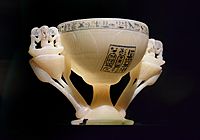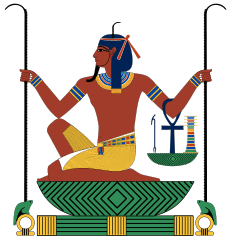Lotus chalice facts for kids
Quick facts for kids Lotus chalice |
|
|---|---|

The lotus chalice in the exhibition Tutankhamun: Treasures of the Golden Pharaoh.
|
|
| Material | Alabaster |
| Size | 18.3 cm high, 28.3 cm wide, cup depth is 16.8 cm. |
| Created | Reign of Tutankhamun (c. 1332–1323 BC), 18th dynasty, New Kingdom |
| Discovered | Tomb of Tutankhamun (KV62), Valley of the Kings |
| Present location | Egyptian Museum, Cairo |
| Identification | JE 67465, Find number 14, GEM 36 |
The Lotus Chalice is a beautiful cup from the tomb of the ancient Egyptian pharaoh Tutankhamun. It is also known as the Alabaster Chalice. The famous archaeologist Howard Carter called it the Wishing Cup. This special object was found in Tutankhamun's tomb, which dates back to the 18th Dynasty. Today, you can see it at the Egyptian Museum in Cairo.
Contents
Finding the Chalice
The tomb of the young King Tutankhamun (KV62) was discovered by Howard Carter. This happened on November 4, 1922. The tomb was in the Valley of the Kings in West Thebes. It was almost untouched for thousands of years.
The Lotus Chalice was one of the first items Carter found. It was on the floor right inside the tomb's first room, called the antechamber. This was not its original spot.
What the Chalice Is Made Of
The Lotus Chalice is carved from a single piece of alabaster. Alabaster is a soft, white stone. The cup itself looks like a white lotus flower that is fully open. You can tell it's a white lotus by its rounded petals.
The handles of the chalice are shaped like blue lotus flowers. These blue lotuses have buds growing upwards next to them.
The God Heh and Eternity
At the top of the blue lotus handles, you can see the ancient Egyptian god Heh. Heh is kneeling on a basket symbol, which is called a neb. In each hand, Heh holds a palm rib. These palm ribs have notches, which were used to count years.
Each palm rib rests on the back of a tadpole. The tadpole sits on a shen ring. The ankh symbol, which means "life," is at the top of each palm rib.
This image of Heh is very important. It represents "millions of years" or eternity.
- The palm rib is a hieroglyph for "year."
- The tadpole stood for the number 100,000.
- The shen ring symbolized eternity.
- A kneeling image of Heh was the hieroglyph for "one million."
So, the chalice shows that King Tutankhamun would have an endless, eternal life. You can find this same design on other items from Tutankhamun's tomb.
The Lotus and Rebirth
The lotus flower was very important in Egyptian mythology. Ancient Egyptians believed the sun god was born from a lotus flower. This lotus would rise from the primeval waters of Nun.
Because of this belief, the king's name in the center of the white lotus flower meant his rebirth. It was a symbol of new life. You can see a similar idea in the Head of Nefertem. This artwork shows Tutankhamun coming out of a blue lotus, just like the newly risen sun god.
What the Chalice Says
The chalice has special words carved into it. These carvings are filled with blue color. Howard Carter copied these words. He asked a scholar named Alan Gardiner to translate them.
King's Names and Titles
On the main part of the lotus cup, you can see the king's names. These include his throne name, 'Nebkheperure', and his personal name, 'Tutankhamun'. It also says he is 'beloved of Amun-Re'. Amun-Re was a very important god. The inscription also calls him 'lord of the Thrones of the Two Lands and lord of heaven, given life for ever.' The writing goes from right to left.
The Royal Titles
The words on the rim of the chalice can be read in two directions. Reading from left to right, starting with the central ankh symbol, it lists Tutankhamun's full five royal titles:
- May (he) live, the Horus Mighty Bull, beautiful of birth.
- The Two Ladies Goodly of Laws, who pacifies the Two Lands.
- The Horus of Gold Exalted of Crowns, who placates the gods.
- King of Upper and Lower Egypt and the Lord of the Two Lands Nebkheperure, given life.
The Wishing Message
Reading from right to left, also starting with the ankh symbol, is a special message:
- May your ka live.
- May you spend millions of years.
- You, who love Thebes.
- Sitting with your face to the north wind.
- Your eyes beholding happiness.
Because of this last message, Howard Carter named the Lotus Chalice the King's Wishing Cup. This wish is even quoted on Howard Carter's second gravestone.
Where to See the Chalice
The Lotus Chalice is usually on display at the Egyptian Museum in Cairo. It was also one of the first objects chosen for special exhibitions. These shows featured items from Tutankhamun's tomb. The chalice was part of the famous world-touring exhibition called Treasures of Tutankhamun.



